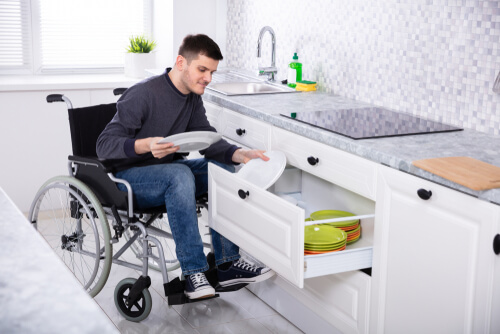
Page contents
What are home adaptations?
Home adaptations refer to any changes to your home which make it easier and safer for you to move around and carry out daily tasks. This article looks at how you pay for home care adaptations and discusses the cost of home adaptations.
Home adaptations can be installed on both a short- and long-term basis and can offer additional support following an injury or diagnosis or to help as you get older.
Home adaptations can include:
- Stairlifts
- Bath lift
- Walk in shower
- Grab rail
- Widened door ways
- Lowered kitchen worktops
- Outdoor ramp or step rail
- Outside lights
- Intercom system
As well as making your home safer, having the right adaptations could enable you to stay in your home for longer by making it more suitable to your needs. This could also help prevent or delay the need to move to a care home.
Home adaptations have a potential saving of £500 million per year for the NHS and social care services, but despite the benefits, it’s not uncommon for people requiring home adaptations to not receive the help they need to make the necessary changes.
What is a home assessment?
Before most adaptations can be installed, you will need to have an assessment of your home. Home assessments will be carried out free of charge by your local council (or trust if you’re in Northern Ireland) and aim to identify what type of adaptations you need as well as any financial support you’re entitled to.
To receive a home assessment, you need to contact your local council or trust. An occupational therapist, or another healthcare professional, will visit your home at a time that suits you. They will ask you a range of questions about your current situation and look around your home to see where you would benefit from adaptations. The assessment will consider your current needs as well as your potential future needs. For example, if you have been diagnosed with an illness, the potential progression of this will be taken into account.
Be as honest as possible
During the assessment, it’s important to be as honest as possible. Although it can be difficult, being honest about the things you are struggling with will make sure that you receive the assistance you need and can live your life as independently and safely as possible.
It might be a good idea to have a partner, family member or friend with you during a home assessment. They can offer support to you, provide additional information where relevant and take notes for you to refer back to.
Alternatively, you can also use an advocate. An advocate is a specially assigned person who will accompany you during the assessment. They can speak on your behalf if you want them to, and they can also help you with things such as filling out forms. Advocates are usually free. You can find out more on the NHS website here.
How do I pay for home adaptations?
Minor adaptations to your house do tend to be free as your local council should be able to cover the costs of adaptations below £1,000. If they cost more than this and you have a disability, you may be eligible for the Disabled Facilities Grant.
Disabled Facilities Grant
A Disabled Facilities Grant is a sum of money provided to a disabled person to help them make changes to their home. It’s available in England, Wales and Northern Ireland.
To be eligible for a Disabled Facilities Grant, you need to either:
- Own the property or be a tenant
- Intend to live in the property during the grant period (which is currently 5 years)
- Be a landlord with a disabled tenant
Adaptations covered by the Disabled Facilities Grant can include:
- Widening doors
- Installing ramps
- Improving access to rooms and facilities – for example, stairlifts or a downstairs bathroom
- Providing a suitable heating system
- Adapting heating or lighting controls to make them easier to use
How much you receive will depend on your household income and any household savings. So if you are a higher earner or have a lot of money in savings, your entitlement might be affected.
The maximum amounts of Disabled Facilities Grant in the UK are:
- England – Up to £30,000
- Wales – Up to £36,000
- Northern Ireland – Up to £25,000
Disabled Facilities Grants are not currently available in Scotland. This is because most adaptations can be funded through the local council.
When you have been approved for a Disabled Facilities Grant, there are different methods you can take to make adaptations for your home.
These include:
- Sourcing contractors yourself – this way, the council may pay you money as the work progresses (in instalments) or they might wait until they have approved the work at the end and give you the lump sum on completion.
- Using approved contractors – this will be the same process as sourcing contractors yourself, but it might be an easier process.
- Carrying out the work yourself – in this case, the council will only pay for materials and supplies for the work and not the cost of labour.
All work needs to be approved before commencement. If you start work before it is approved, you might not receive the funds to pay for this.
Independence at Home
Independence at Home is a UK charity that provides grants to people who have a physical or learning disability or long-term illness and who are in financial need. They can help towards the cost of equipment, home adaptations or other essential items to help you continue to live independently, comfortably and safely.
For example, a grant could go towards:
- A powered wheelchair, improving mobility in and around the home and in the local community.
- A riser-recliner chair, to be able to sit comfortably and go from sitting to standing more easily.
- A wet room, to be able to have a shower independently and safely.
Grants range from £300 to £600.
To receive financial assistance from Independence at Home, you need to be referred by a professional health or social care worker, or by a charity. This person will submit an application on your behalf.
Personal funding
If you are fortunate enough to be in a position to fund home adaptations yourself, this may be a good option where other routes are not available. Personally funding any adaptations also means that work can begin as soon as you are happy to go ahead, and at a time that suits you.
You should do as much research as you can before you make any final decisions to ensure you are choosing the best adaptations for you and are receiving the best price for these. It might be a good idea to enlist the help of a family member or friend if possible.
There are also organisations dedicated to helping people find the best options for adaptations. These organisations will point you in the right direction as to what you might need and where you can get this from.
Living Made Easy
Living Made Easy is provided by the DLF, a charity previously known as the Disabled Living Foundation. They provide free and impartial advice and information on solutions, gadgets, adaptations and aids to make life easier.
If you are looking to fund your own home adaptations, you can use Living Made Easy to find information on different types of equipment and current retailers in the UK.
Information is provided for equipment such as:
- Stairs and lifts
- Walking aids
- Wheelchairs, scooters and buggies
- Mobility services
- Cars and travel
Not all retailers are signed up to Living Made Easy, so bear in mind that you might be provided with a limited shortlist.
Ask SARA
Ask SARA, part of Living Made Easy, is an online tool. By answering a number of questions, you will be given a report detailing different things you might find helpful in your everyday life, including equipment or ideas to help, as well as details of where you can buy these things.
Home Improvement Agencies (HIA)
Home Improvement Agencies (HIAs) are organisations that help people who are older, disabled, or vulnerable to continue living safely and independently for as long as possible. They provide information, advice and support for people to make modifications to their homes.
In Scotland HIAs are also known as Care & Repair services.
HIAs provide assistance with:
- Housing options
- Disabled adaptations
- Home repairs/handyperson
- Hospital discharge and re-ablement
- Making homes more energy efficient
- Welfare and benefits advice
Click here to find out more about your local HIA and what services are available.


